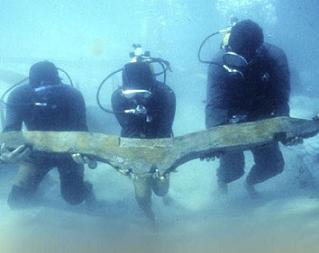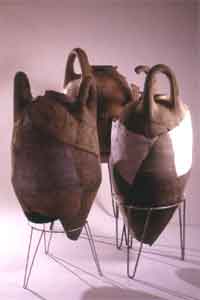
A substantial portion of the wooden hull structure survived. Among the artifacts found aboard were 70 items of ceramic ware, ropes, a lead ingot, a set of wooden carpenter's tools, 12 tons of rocks, mainly blue schist and Gabro, and - lying in position in the sandy bottom, although it had not actually been used - a perfectly intact, one-armed wooden anchor, unique in its style, its ropes still attached.
Following customary procedures, he notified a representative of the Israel Antiquities Authority of his finds, and went to find Dr. Elisha Linder, the maritime historian/archaeologist who lives on the kibbutz. Linder realized that the find was an intact, 2,400-year-old wooden-hulled merchantman, originally 13.5 meters in length and 4 meters in width, in a remarkable state of preservation. It was lying perpendicular to the shore where it had, for reasons still unknown, been beached.
 Divers excavating the anchor of the ship
Divers excavating the anchor of the ship Amphorae, used during this time for the transport and storage of various products, were found at the excavation site of the ship
Amphorae, used during this time for the transport and storage of various products, were found at the excavation site of the ship Carpenter tools found within the ship wreck
Carpenter tools found within the ship wreck

